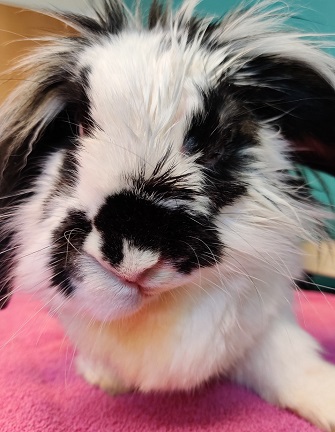Rabbit Ear Disease
Clinical Connections – Spring 2022
Nadene Stapleton, RVC Exotics and Small Mammals
Here at RVC Exotics, ear disease remains one of the most common problems encountered in rabbits. Despite this, it is a seriously underdiagnosed condition in companion rabbits – particularly lop-eared breeds, which are over-represented.

Lopped rabbits likely develop the ear pathology as a result of the bent ear conformation trapping wax in the lower canal, which causes inflammation and infection. Excessive amounts of wax build up and migrate through a ‘path of least resistance’, often laterally out of the canal and under the skin at the location of the bend of the ear. This can sometimes be palpated as a swelling of the ear base. Alternatively, this material travels down through the ear drum into the deeper structures of the middle ear, causing a painful abscess. In this scenario there may be no obvious swelling or other clinical signs.
Rabbits – unlike cats and dogs – are rarely seen scratching ears or shaking their head, even in the face of a severe ear condition.
The caseous or solid nature of rabbit pus means such infections can become expansive and rupture the bone of the bulla. Such pathology is not easily palpable on physical examination and rabbits are extremely good at hiding pain. This creates a situation where severe, painful ear disease remains undetected.
Some rabbits may develop a head tilt or facial asymmetry (Figure 1) as the first sign of an ear infection due to facial nerve damage. This leads to contracture of the facial muscles of the affected side. Unfortunately, by this stage the problem is quite advanced.
Computed Tomography (CT) remains the most effective way to diagnose and determine the extent of ear pathology in this species (Figure 2.). In one retrospective study performed at the RVC, we found that 26% of rabbits presenting for CT had ear disease and 45.5% of those diagnosed with otitis media were not being scanned for ear problems specifically i.e. a lot of subclinical ear disease is diagnosed on CT scans performed on rabbits for other reasons.
Management can be medical or surgical depending on the severity of the condition. Surgery is most common as rabbits rarely present in the early stages of the disease. Surgery involves the removal of large sections of diseased ear canal, infected bone and pus and wax to reduce pain and suffering in rabbits who have already lost hearing. One of the most common techniques is partial ear canal ablation and bulla osteotomy (PECA-BO) .
These surgeries are extensive and often the wounds are sutured open – a technique called ‘marsupialisation’ to allow post-surgical flushing. Despite the drastic appearance of these rabbits postoperatively, this technique gives us the best chance at preventing recurrence of infection and is well tolerated. Antibiotic choice is dependent on the results of culture, and sensitivity tests performed on surgical tissue samples (which are more accurate than culturing pus in rabbits). Flushing of the surgical sites is performed daily for several weeks following the surgery, which requires a lot of dedication from owners.
.jpg)
Making sure that the owners and breeders of lop breed rabbits as well as vets are all aware of this breed's predilection for ear disease is essential. This means any potential rabbit owners can be educated about disease prevalence in the breed and ensure they have their rabbit insured to cover the costs of treating such a condition if it arises. Being aware of this disease will also prompt regular veterinary checks to specifically look for this difficult to diagnose disease.
The intermittent use of ear cleaners designed to remove wax from ear canals may help reduce the risk – although there are no rabbit-specific ear cleaners on the market. No studies have been conducted into prevention strategies so far.
Nadene Stapleton was named UK Rabbit Vet of the Year at last November’s Burgess Excel Vet Awards and the RVC’s Beaumont Sainsbury Animal Hospital was named Best Rabbit Practice of the Year
